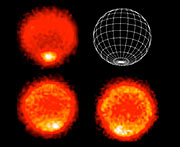Persbericht
A Warm South Pole? Yes, on Neptune!
Summer season on Neptune creates escape route for methane
18 september 2007
An international team of astronomers using ESO's Very Large Telescope has discovered that the south pole of Neptune is much hotter than the rest of the planet. This is consistent with the fact that it is late southern summer and this region has been in sunlight for about 40 years.
The scientists are publishing the first temperature maps of the lowest portion of Neptune's atmosphere, showing that this warm south pole is providing an avenue for methane to escape out of the deep atmosphere.
"The temperatures are so high that methane gas, which should be frozen out in the upper part of Neptune's atmosphere (the stratosphere), can leak out through this region," said Glenn Orton, lead author of the paper reporting the results. "This solves a long-standing problem of identifying the source of Neptune's high stratospheric methane abundances."
The temperature at the south pole is higher than anywhere else on the planet by about 10 degrees Celsius. The average temperature on Neptune is about minus 200 degrees Celsius.
Neptune, the farthest planet of our solar system, is located about 30 times farther away from the Sun than Earth is. Only about 1/900th as much sunlight reaches Neptune as our planet. Yet, the small amount of sunlight it receives significantly affects the planet's atmosphere.
The astronomers found that these temperature variations are consistent with seasonal changes. A Neptunian year lasts about 165 Earth years. It has been summer in the south pole of Neptune for about 40 years now, and they predict that as winter turns to summer in the north pole, an abundance of methane will leak out of a warm north pole in about 80 years.
"Neptune's south pole is currently tilted toward the Sun, just like the Earth's south pole is tilted toward the Sun during summer in the Southern Hemisphere," explains Orton. "But on Neptune the antarctic summer lasts 40 years instead of a few months, and a lot of solar energy input during that time can make big temperature differences between the regions in continual sunlight and those with day-night variations."
"Neptune has the strongest winds of any planet in the Solar System; sometimes, the wind blows there at more than 2000 kilometres per hour. It is certainly not the place you would like to go on a holiday," he adds.
The new observations also reveal mysterious high-latitude 'hot spots' in the stratosphere that have no immediate analogue in other planetary atmospheres. The astronomers think that these hot spots are generated by upwelling gas from much deeper in the atmosphere.
Methane is not the primary constituent of Neptune's atmosphere, which, as a giant planet, is mostly composed of the light gases, hydrogen and helium. But it is the methane in Neptune's upper atmosphere that absorbs the red light from the Sun and reflects the blue light back into space, making Neptune appear blue.
The new results were obtained with the mid-infrared camera/spectrometer VISIR on ESO's VLT 8.2-m Unit Telescope 3 (Melipal).
Meer informatie
"Evidence for Methane Escape and Strong Seasonal and Dynamical Perturbations of Neptune's Atmospheric Temperatures", by Glenn S. Orton et al., is published by the research journal Astronomy and Astrophysics.
The team of astronomers includes Glenn S. Orton, Cédric Leyrat, and A. James Friedson (Jet Propulsion Laboratory, California Institute of Technology, USA), Thérèse Encrenaz (LESIA, Observatoire de Paris, France), Eric Pantin (Centre d'Etudes Atomiques, France), and Richard Puetter (Center for Astrophysics & Space Sciences, University of California, USA).
Contact
Glenn Orton
Jet Propulsion Laboratory
California, USA
Tel: +1-818-354-2460
E-mail: go@orton.jpl.nasa.gov
Thérèse Encrenaz
LESIA
Paris, France
Tel: +33 1 45 07 76 91
E-mail: go@orton.jpl.nasa.gov
Over dit bericht
| Persberichten nr.: | eso0741 |
| Legacy ID: | PR 41/07 |
| Naam: | Neptune |
| Type: | Solar System : Planet |
| Facility: | Very Large Telescope |
| Instruments: | VISIR |
| Science data: | 2007A&A...473L...5O |

